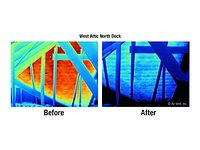
The 454,000-square-foot living roof area of the Ford Dearborn Truck Assembly Building.

The Ford Dearborn Truck Assembly Building opened in 2004.
The 1.15-million-square-foot facility was constructed at the historical Ford Motor Company Rouge River Industrial Complex in Dearborn, Mich. An environmentally friendly design was paramount to the project from the outset.
Ford Motor Land engaged renowned environmental architect William McDonough to serve as the consulting architect with the project architects, ARCADIS Giffels. The plan was to design a building that would allow the automobile manufacturer to produce vehicles efficiently and profitably in an environmentally friendly, modern and versatile manufacturing facility.

The construction of the green roof was completed by applying a conventional roof system over the structural metal deck.
Resulting Design
The resulting design not only succeeded in achieving the initial objectives, it has become a template for future Ford Manufacturing facilities. The design allowed the building to achieve LEED status through the use of structural steel, natural lighting and the green roof assembly. Structural steel contributes to the building’s sustainability because it is nearly 100 percent recyclable. Steel is one material that can be recycled repeatedly without losing quality. The structure was erected using nearly 8,500 tons of structural steel.Natural lighting was also implemented in the design to reduce large-scale energy usage. To help provide natural lighting into the interior areas a total of 36 gabled skylights were installed in the roof covering the manufacturing area.
In addition, a total of 10 monitors, each 33 feet, 4 inches by 100 feet, were installed over the employee mezzanine. These installations provided natural light into the building and reduced the need for artificial light during the daylight hours. Photo sensors were installed in the artificial lighting to brighten or darken the lights as needed. This allows for an even distribution of light throughout the facility when the sun is in the clouds. To further enhance the natural lighting, all of the exposed steel was painted a bright white to provide reflectance and to lighten the spaces.

The roof construction consisted of a modified bitumen roof membrane set over rigid insulation.
Largest Garden Roof
When the Ford Dearborn Truck Assembly Building opened in 2004 it had the distinction of housing the largest “garden roof assembly” in North America - perhaps the world. The 454,000-sqaure-foot (about 10 1/2 acres) living roof area was designed to control the water runoff from the roof area to the aging underground infrastructure. The actual roof construction was completed in 2002. As the roof enters its sixth year, we thought it would be a good idea to find out how the industry’s most famous roof has performed to this point.On a cold Michigan morning I sat down with Roger Gaudette of Ford Land to talk about the performance of the garden roof. Gaudette served as the liaison between McDonough, Giffels, Walbridge Aldinger (general contractors) and Ford. His involvement with the project was from inception of the project in the late 1990s through 2006, when he was reassigned within Ford Land.
“The roof has performed extremely well,” Gaudette said as a fresh blanket of snow covered the grounds of Ford Land’s offices in Dearborn, Mich., which are in the shadows of Ford World Headquarters and the Rouge Plant. “I do not believe there have been any issues with the roof except for some shrinking or pulling in of the garden area from the L-shaped metal that held it in place.”
This issue did not affect the membrane and was filled in with sedum matching the original construction. There have not been any reported leaks to the roof.
Roof Construction
The construction of the roof was complete by applying a conventional roof system over the structural metal deck, Gaudette said. “This gives us the opportunity to add garden components to the other areas in the future,” he commented.The roof construction consisted of a modified bitumen roof membrane set over rigid insulation. The SBS Modified Membrane consisted of a base ply and cap sheet set in hot asphalt. Isocyanurate insulation was fastened through the galvanized metal deck and cover board insulation was set in hot asphalt over the isocyanurate layer.
The garden roof assembly consisted of protection board; a thin, four-layer growth media/drainage mat system, and a low-maintenance perennial ground cover called sedum were placed over the membrane.
Gaudette traveled with members of the design team to Germany prior to the roof design to inspect garden roofs completed using Xero Flor, an international firm specializing in green-roof and other related systems that were used on this project.
The primary intent of the living roof application was to filter the storm water and minimize the storm water runoff from reaching the underground infrastructure. Storm water becomes saturated and is retained within the system. The total building size is 1.15 million square feet and the capacity of the runoff would exceed the capabilities of the complex’s aging (early 1900s) sewer system. The cost of a new sewer system would have been expensive and could have jeopardized the entire project.
Water Runoff Rates
Ford has conducted testing on the completed roof system to decipher water runoff rates, Gaudette stated. “What we tried to do once we got the roof on and established was to test water runoff rates during different storms,” he said.Ford hired Giffels to test water runoff by setting up a matrix and monitoring each rainfall.
“The matrix was set up with heavy rains - long duration, heavy rains - short duration all the way through light rains - short durations,” Gaudette said. “They analyzed the water runoff composition to determine the extent of sedum loss and they looked at different areas of the building for the water storm run off plan.”
Preliminary testing indicates that the system has achieved its objectives despite a thin (average 2 inches) sedum layer application.
Landscaping a Living Roof
WH Cannon a local landscape company that Ford has hired for this building has completed maintenance of the living roof. Gaudette indicated that the landscaping company has annual responsibility “of checking the viability of the system, determining if fertilization is required, applying it and working with the water irrigation.”Gaudette stated that watering has been limited to the dry season of the year, which is usually in July and August.
Application of the living roof has stimulated the habitation of the wildlife on the site. Gaudette said he was surprised by the amount of habitat on the roof. “From my perspective, one of the surprises has been the amount of wild life,” he said.
Gaudette noted the abundance of nestling killdeers, Canadian geese nests, insects, bee’s and dragonflies that are living on the roof.
“From a habitat perspective, it has done very well,” he said.
Challenges and Complexities
A project of this magnitude was not without challenges and complexities. The physical size of the project and rigid schedule demands made the project challenging. Integrating environmental design into a blue-collar construction community was also complex. Gaudette noted that one of the major challenges of the project was getting approvals from the city of Dearborn.“The challenge became bringing them up to speed with what we were trying to do.” Gaudette said. “This construction was new to the municipality and they were trying to interrupt codes.”
“They (the city of Dearborn) were interested in determining what does it mean when you put a green roof on a building and they were concerned about fire codes what does it mean from a fire protection standpoint,” Gaudette said, indicating that “getting everybody on the same page - including internal Ford employees - and convincing them that this something that is viable and a good thing to do was a challenge.”
Gaudette credited the team approach as the reason for the success of this project. “We had a goal that we were going to incorporate and we were not going to let anything get in our way of achieving these goals,” he said.
Overall from a design and application perspective Gaudette feels that Ford reached its goals on this project.
“I think we first looked at the roof and we knew that energy savings itself was not going to be the driving factor,” Gaudette said. “I think it was everything together. The longevity of the roof combined with the environmental aspects and some energy savings were the three key items that pushed us to do this.”
In Conclusion
Since the completion of the Dearborn Truck Assembly Building, Ford has applied living roofs on two facilities; one in California and another at their World Headquarters in Dearborn.Gaudette said he is optimistic about the further application of living roofs at Ford facilities.
“I think we hoped that this would be one of a number of roofs that we would start and I think we are looking to see how this will perform and what the affect on the actual membrane is before we continue down the road with anything of this magnitude,” he said. “We will look at facilities as we build and expand and look at all environmental aspects, which will include green roofs as part of the agenda to achieve LEED certification.”


